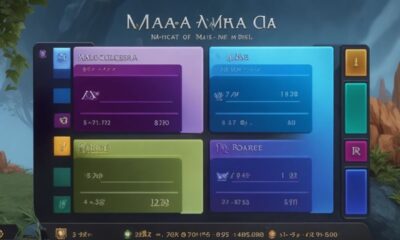

Tools
MTG Power Level Calculator
Cards counted
?
?
Recommended number is between 100 – 180
?
Recommended number is between 12 – 23
?
Recommended number is between 12 – 20
?
Recommended number is between 5 – 10
?
Recommended number is between 75 – 100
?
Recommended number is between 0 – 15
?
Recommended number is between 0 – 15
?
Recommended number is between 0 – 15
?
Recommended number is between 5 – 15
?
Recommended number is between 5 – 15
Results
Your deck power level is:
0
Welcome to our fantastic MTG Power Level Calculator designed specifically to help you optimize your deck building process! Whether you’re a seasoned player looking to fine-tune your deck or a beginner eager to learn the ropes, this calculator is here to assist you in creating a winning strategy. By inputting various values related to your deck, you’ll gain valuable insights and make informed decisions that will take your gameplay to the next level.
So, let’s dive into the step-by-step guide on how to make the most of this calculator:
Step 1: Total Counted
First things first, enter the total number of cards in your deck into the “Total Counted” field. This serves as the foundation for evaluating the other values. Knowing the size of your deck helps us provide accurate recommendations and suggestions.
Step 2: Total Main Deck Mana Value
Next up, input the cumulative mana cost of all the cards in your main deck into the “Total Main Deck Mana Value” field. This value gives us insights into your deck’s mana curve and resource management. A well-balanced mana curve ensures a smooth flow of resources during the game, so it’s essential to get this right.
Step 3: Number of Ramp Cards
Time to consider the number of cards in your deck that generate additional mana or offer mana acceleration. These cards are often referred to as “ramp” cards. Enter the total count of these valuable resources into the “Number of Ramp Cards” field. Striking the perfect balance in this area can significantly impact your deck’s speed and efficiency.
Step 4: Number of Cards that Draw
Drawing cards is like opening new doors of opportunity in your deck. It keeps your options fresh and your hand full. In the “Number of Cards that Draw” field, specify how many cards in your deck allow you to draw additional cards from your library. Having a healthy number of draw cards enhances your deck’s consistency and flexibility, so choose wisely.
Step 5: Number of Tutors
Imagine having a personal assistant who can fetch the exact card you need at any given moment. That’s where tutor cards come in. They allow you to search your library for specific cards, giving you the tools you require when the situation demands it. In the “Number of Tutors” field, enter the total count of tutor cards you’ve included in your deck. Tutors can significantly improve your deck’s consistency by increasing the chances of finding specific cards or combos.
Step 6: Analyze Results
Once you’ve provided all the necessary information, it’s time to unveil the insights! Click on the “Calculate” button, and our calculator will work its magic, analyzing the inputted values and providing you with valuable recommendations. These suggestions are tailored to optimize your deck and give you the upper hand in your games.
Step 7: Iterate and Refine
Take the suggestions provided by the calculator as a starting point, but remember that deck building is an art. Experiment with different values, adjust card counts, and evaluate the impact of each change on your deck’s performance. Through iteration and refinement, you’ll be able to fine-tune your deck to match your unique playstyle and strategic preferences.
With the help of this user-friendly deck calculator, you can streamline your deck building process, increase your chances of success, and make more informed decisions during gameplay. Happy deck building, and may your future games be filled with excitement and triumph!






